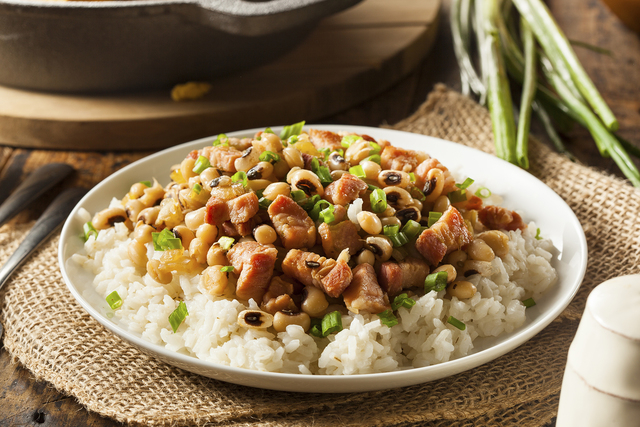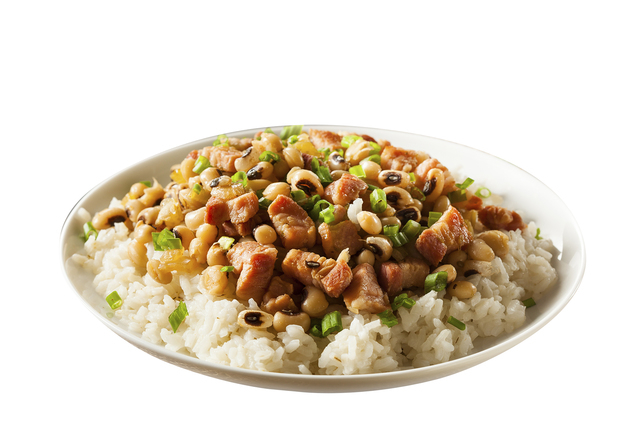These foods are supposed to bring you good luck in ‘15
Did 2014 measure up to your expectations? If so, we probably saw your year on Facebook. If not, you might consider what you eat on Thursday, because a lot of people believe your New Year’s Day fare can affect how you’ll fare during the coming year.
“Lots of cultures have something that is special to that symbolism of predicting the year to come,” said Elizabeth Nelson, associate professor of history at the University of Nevada, Las Vegas. “One of the things about these traditions is that they’re mostly symbolic. They’re connected to ideas that people have about luck.”
Across a variety of cultures, Nelson said, people eat cabbage or collard greens on New Year’s Day. That’s apparently in part, she said, because money is green — at least in this country — but also because cabbage is harvested late in the fall.
“It comes at the perfect time when the sauerkraut is finished doing its thing,” she said.
Indeed, sauerkraut or other forms of cabbage are traditional New Year’s foods in countries including Germany and Austria. Pork is another, reportedly because pigs root in a forward direction.
“There’s lots and lots of pork,” Nelson said. “The weirdest food that I came across is in the Czech Republic, where there is a tradition of eating boiled pork head with horseradish and apple.”
In Poland, she said, it’s a tradition to eat pickled herring for good luck on New Year’s Day. Beans are considered good luck in many cultures, such as the lentils of Eastern Europe. In Scotland, believers eat oat cakes called hogmanays.
“Those are good luck, specially baked for New Year’s Day eating,” she said of the latter.
Grapes play a good-luck role in many Hispanic cultures, she noted. Specifically, 12 grapes. She said the shape of the grape, the roundness, relates to the hope for a well-rounded year, the number 12 for completeness, representing the 12 months of the year.
“It’s less that grapes are delicious than what they look like,” Nelson said.
Chickens are out as good-luck tokens because they scratch backward, but there are other reasons.
“In the Philippines, they don’t like to eat animals like chicken or fish because they are scavenging animals, and they don’t want to have that kind of symbolism, of scavenging, to be the kind of year they’re going to have,” she said.
But in some cultures, fish are prized, she added, because the many scales are silvery, representing money. In others, long noodles are desired because they represent long life, and sticky rice “because it makes good luck stick to you.”
In the United States, perhaps the most widespread culinary good-luck tradition for celebrating New Year’s Day is Hoppin’ John — black-eyed peas, rice and usually some form of pork — which originated in the South.
“Probably that comes from South Carolina originally, because that’s where rice was largely cultivated,” Nelson said. “That would have been the place where that would have been most commonly available.”
The name, she said, is thought to be a bastardization of pois a pigeon, which is the French name for the peas.
Amy Bearden, room chef of the Feast Buffet at Santa Fe Station, isn’t a native Southerner, but she said her “culinary upbringing” is Southern, because of several years she spent working for the House of Blues. And she knows a thing or two about Hoppin’ John.
“It showed up around Civil War time,” Bearden said. “They planted black-eyed peas for their livestock. All of the other crops were stolen, so they relied on the peas for survival. They considered themselves very lucky to have them.”
Lola Pokorny, chef/owner of Lola’s: A Louisiana Kitchen near downtown Las Vegas and in Summerlin, gave another aspect of the legend in a summary she’s giving her customers.
“Folklore says that Union soldiers left behind only black-eyed peas and collard greens, mistaking them for animal feed,” Pokorny wrote. “Rich in nutrients, these humble foods enabled Southern folks to survive.”
Bearden is bringing the tradition to Santa Fe Station, which will serve black-eyed peas and collard greens for dinner tonight and all day Thursday.
“The black-eyed pea is good fortune; it represents coins,” she said. “And the greens represent cash. I know if you’re doing it at home you either put a penny or a dime in with the black-eyed peas and whoever gets the penny or dime is said to have the best luck for the coming year.”
Lola’s will serve “all of the traditional things” on New Year’s Day.
“We’re opening at noon to let everybody have that hangover settled out,” Pokorny said. “We’ll run until 8 that day.”
She’ll serve black-eyed peas with pork, steamed cabbage and cornbread, which she said represent health, wealth and prosperity.
“What they’re trying to do is produce those good things in the beginning,” she said. “We all have traditions, but these are the Southern ones.”
Like all traditional recipes that move up through the generations, the “correct” version of Hoppin’ John is the one you’re used to. If you’d like to try to better your luck in 2015, here are a few variations.
HOPPIN’ JOHN
2 cups dried black-eyed peas
½ pound salt pork, quartered
2 cups chopped onion
1 cup chopped green pepper
1 bay leaf
2½ cups water
1 cup uncooked long-grain rice
1½ teaspoons salt
¼ teaspoon black pepper
¼ teaspoon ground red pepper
Few drops of hot sauce
Sort and wash peas; place in a large Dutch oven. Add water 2 inches above peas and bring to a boil. Boil 1 minute; cover, remove from heat and let stand 1 hour.
Drain peas and return to Dutch oven; add salt pork and next 3 ingredients. Cover with water; simmer, covered, 1½ to 2 hours or until peas are tender and water has cooked very low. Remove salt pork, if desired.
Add 2½ cups water and remaining 5 ingredients to peas. Cover and cook over low heat 20 minutes or until rice is tender. Discard bay leaf before serving.
Serves 8 as a side dish.
— Recipe from Southern Living
HOPPIN’ JOHN
1 tablespoon olive oil
1 large ham hock
1 cup onion, chopped
½ cup celery, chopped
½ cup green pepper, chopped
1 tablespoon chopped garlic
1 pound black-eyed peas, soaked overnight and rinsed
1 quart chicken stock
Bay leaf
1 teaspoon dry thyme leaves
Salt, black pepper and cayenne
3 tablespoons finely chopped green onion
3 cups steamed white rice
Heat oil in a large soup pot, add the ham hock and sear on all sides for 4 minutes. Add the onion, celery, green pepper and garlic, cook for 4 minutes. Add the black-eyed peas, stock, bay leaf, thyme and seasonings. Bring to a boil, reduce the heat and simmer for 40 minutes, or until the peas are creamy and tender, stirring occasionally. If the liquid evaporates, add more water or stock. Adjust seasonings and garnish with green onions. Serve over rice.
Serves 10.
— from Emeril Lagasse and the Food Network
HOPPIN’ JOHN
2 tablespoons butter
1 small onion, chopped
1 small red bell pepper, chopped
Garlic powder
2 cups black-eye peas, cooked
2 cups cooked rice
House Seasoning (recipe follows)
8 sprigs fresh parsley, for garnish
Melt the butter in a large skillet over medium heat. Add onion, bell pepper and garlic powder, to taste, and cook for 5 minutes. Add peas and rice and cook an additional 10 to 15 minutes. Be careful not to overcook; this dish is best if the bell pepper and onion still have a crunch to them. Add House Seasoning, to taste. Garnish each serving with sprig of parsley.
For House Seasoning, mix 1 cup salt, ¼ cup black pepper and ¼ cup garlic powder. Store in an airtight container for as long as 6 months.
Serves 6 to 8.
— Recipe from Paula Deen and the Food Network
HOPPIN’ JOHN
1 cup dried black-eyed peas
6 ounces smoked kielbasa sausage
1 medium onion
2 garlic cloves
2 celery ribs
½ fresh jalapeno chili
1 bay leaf
1½ tablespoons vegetable oil
1¾ cups chicken broth
3 tablespoons chopped fresh coriander leaves
Accompaniment: cooked rice
To quick-soak the black-eyed peas, pick over the peas and in a saucepan cover with cold water by 2 inches. Bring water to a boil and boil peas 2 minutes. Remove pan from heat. Soak peas 1 hour. Drain in a sieve.
Quarter kielbasa lengthwise and cut quarters crosswise into ½-inch pieces. Chop onion and mince garlic. Cut celery crosswise into ½-inch-thick slices. Wearing rubber gloves, seed and mince jalapeno.
In a 3-quart heavy kettle cook kielbasa, onion, garlic, celery, jalapeno and bay leaf in oil over moderate heat, stirring, until onion is softened. Add peas and broth and simmer, covered, 20 minutes, or until peas are tender. Discard bay leaf and stir in coriander and salt and pepper, to taste.
Serve spooned over rice.
Serves 4.
— Recipe from Gourmet
Contact reporter Heidi Knapp Rinella at hrinella@reviewjournal.com or 702-383-0474.
Good for New Year’s?

It’s unanimous

Count ‘em first
 Maybe so
Maybe so
What do others say?

Here are some other lucky lists you might enjoy. Woman’s Day recommends long noodles. Epicurious adds notes on what to avoid, and Bon Appetit has suggestions including bagels and doughnuts.






























